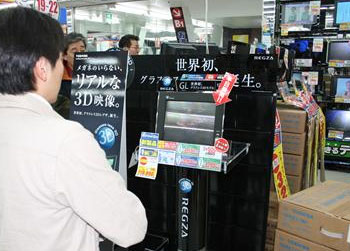Sales of the Toshiba GL1 series of glasses-free 3D TV displays did not even reach half of the company’s initial expectations since they were launched eight weeks ago in Japan. However, the disappointing data is more likely to be due to the models’ poor price-to-screen-size ratio, rather than outright rejection of autostereoscopic 3D technology by the Japanese public.

In an interview with Bloomberg, Toshiba’s visual product company president Masaaki Osumi revealed that the Tokyo-headquartered corporation had originally set a monthly sales target of one thousand units for the 20-inch Toshiba 20GL1, and the same number for the 12-inch 12GL1. Unfortunately, the TV manufacturer only managed to shift 500 units of the larger set, with even fewer of the smaller model being bought by consumers.
The relatively underwhelming screen size for the price seems to be the main obstacle hindering the uptake of these glasses-free 3D TVs. At launch, the Toshiba 12GL1 commanded a price around 120,000 yen (roughly £900), and its larger sibling 20GL1 would cost twice as much. It was always going to be an uphill task to persuade potential buyers to spend this amount of money on HDTV displays with such small screens, especially in the knowledge that bigger-sized 3D televisions usually deliver a more immersive 3D viewing experience.
The obvious solution, Mr Osumi said, was to offer glasses-free 3D displays with larger screen sizes, but this is not as easy as it sounds. The current version of autosteroscopic 3D technology works by presenting slightly-overlapped parallax images to the eyes, which the brain then fuses to create an illusion of three-dimensional depth.
On a bigger panel, it is more difficult to render these images with precision sans 3D glasses, and so the 3D effect would be less convincing (particularly when viewed off-axis). The Toshiba head himself conceded that the company’s engineers have to solve a “mountain” of technical issues before larger glasses-free 3D TV models can be successfully brought to market during the second half of 2011.
Source: Bloomberg